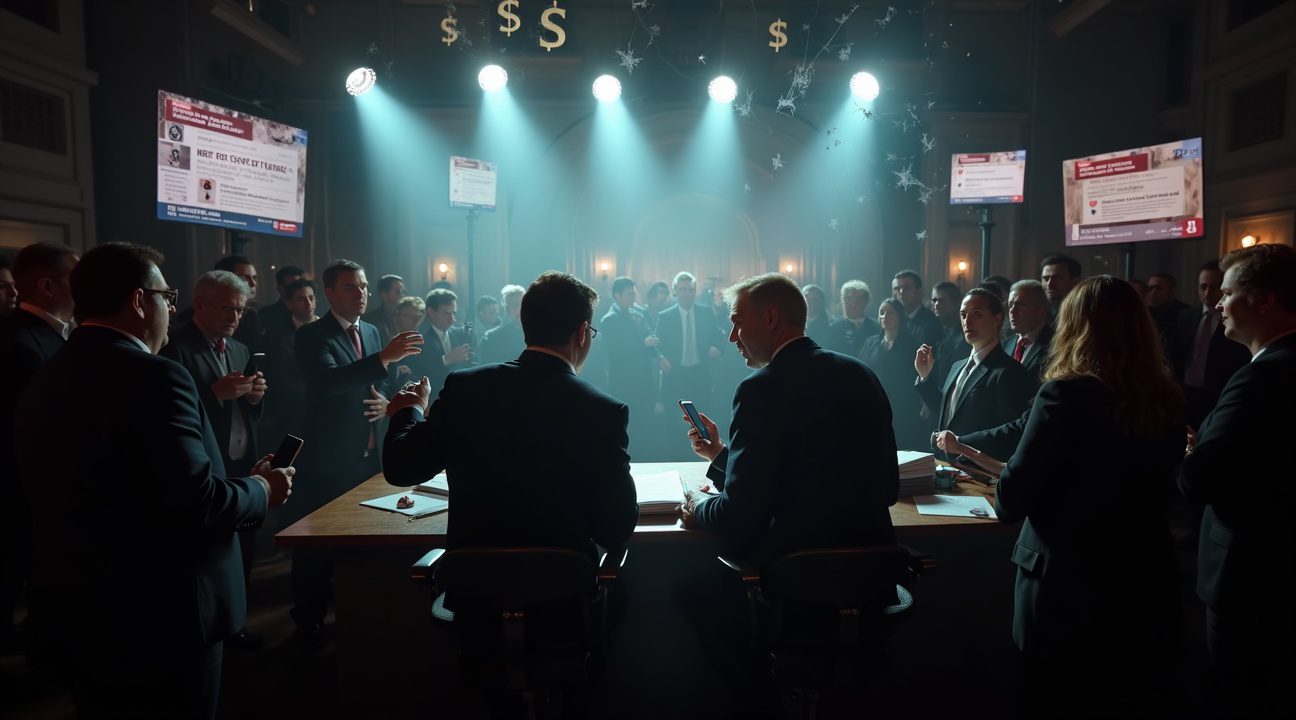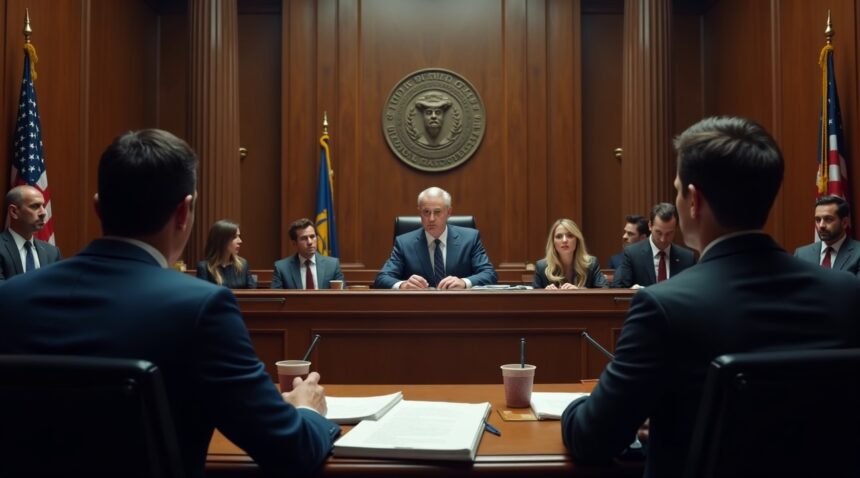Justin Baldoni’s $400 million defamation lawsuit against actress Blake Lively unraveled in October 2025, following its dismissal by the U.S. District Court for the Southern District of New York due to critical procedural errors by Baldoni’s legal team.
Legal Setback for Baldoni
The lawsuit crumbled after Baldoni’s team failed to meet court-imposed deadlines to amend their complaint. Judge Lewis Liman granted them multiple chances, but the legal team did not comply in time. The 179-page filing attempted to implicate numerous celebrities and industry figures in what Baldoni claimed was a calculated effort to sabotage his professional reputation.
Allegations in the Complaint
Baldoni’s initial lawsuit leveled serious accusations at several public figures:
- Blake Lively, Ryan Reynolds, and their publicist were accused of civil extortion, defamation, and executing a coordinated smear campaign.
- Court filings involved attempts to subpoena celebrities like Taylor Swift, although her team denied any major involvement beyond a music licensing agreement.
- Central to the conflict were disputes marketing strategies and creative control during the production of the film It Ends with Us.
Response from Blake Lively
Following Baldoni’s lawsuit, Blake Lively filed formal complaints with the California Civil Rights Department. She alleged sexual harassment, a hostile work environment, and retaliatory actions, with her case slated for trial in March 2026.
Celebrity Involvement
The lawsuit dragged in multiple A-list names. Among the most notable:
- Taylor Swift was named in subpoenas, largely over the use of one of her songs in the film. Her representatives clarified she had minimal knowledge of the deeper legal feud.
- Ryan Reynolds, both a key figure in the defamation suit and Lively’s spouse, was also implicated in the alleged smear effort.
Origin of the Conflict
The legal battle can be traced to behind-the-scenes friction during the filming of It Ends with Us. These tensions allegedly included:
- Disputes over creative direction between Baldoni and the production team.
- Disagreements surrounding marketing and promotions, which reportedly created a dysfunctional workplace.
While Baldoni’s lawsuit aimed to expose what he claimed was a destructive campaign to harm him, the lack of procedural rigor and concrete evidence ultimately led to the case’s dismissal. For more insight on Justin Baldoni, visit his Wikipedia page.
Court Dismisses Baldoni’s $400 Million Legal Challenge in October 2025
The U.S. District Court for the Southern District of New York delivered a decisive blow to Justin Baldoni’s ambitious legal challenge in October 2025. Judge Lewis Liman’s final order on October 31, 2025, marked the end of a contentious legal battle that had stretched across several months and generated significant media attention.
Failed Deadlines Lead to Case Dismissal
Baldoni’s legal team failed to meet the court’s critical deadline for amending their complaint, resulting in the lawsuit’s dismissal. The procedural failure came after Judge Lewis Liman had given the plaintiff multiple opportunities to strengthen their case. This dismissal followed months of unsuccessful legal maneuvering that included failed motions for gag orders and attempts to subpoena high-profile celebrities.
The litigation had been particularly aggressive in scope, with Baldoni’s team even attempting to subpoena Taylor Swift as part of their strategy. These efforts proved fruitless and may have contributed to the court’s growing impatience with the case’s management. I observed that such high-profile subpoena attempts often backfire in civil litigation, creating additional complications rather than strengthening the plaintiff’s position.
Extensive Documentation Couldn’t Save the Case
Despite submitting substantial documentation, including a 179-page complaint and a comprehensive 168-page timeline of events, Baldoni’s legal team couldn’t overcome the fundamental weaknesses in their case. The extensive paperwork demonstrated the complexity of the dispute but ultimately failed to meet the court’s standards for a viable legal challenge.
Multiple motions to dismiss had been filed throughout the proceedings, indicating that the defense had consistently challenged the lawsuit’s foundation. The public legal filings revealed a pattern of procedural missteps that would eventually doom the case. Entertainment industry legal experts had predicted this outcome, noting that the massive $400 million claim lacked sufficient legal grounding.
The final order represents more than just a procedural failure – it signals the end of what many considered an overly ambitious legal strategy. Baldoni’s attempt to pursue such a substantial monetary claim through the federal court system has now concluded without any financial recovery. The case serves as a reminder that even well-funded litigation requires solid legal foundations and adherence to court procedures to succeed. Judge Liman’s decision effectively closes this chapter of the ongoing dispute between the parties.
Baldoni Accused Lively of Civil Extortion and Career Sabotage
I find it fascinating how Hollywood disputes can escalate into massive legal battles. In January 2025, Justin Baldoni launched a staggering $400 million lawsuit against Blake Lively, her husband Ryan Reynolds, and their publicist. The director and his associates at Wayfarer Studios didn’t hold back in their accusations, claiming civil extortion, defamation, and invasion of privacy.
The Core Allegations
Baldoni’s legal team painted a picture of calculated manipulation and retaliation. They argued that Lively weaponized false claims of sexual harassment as leverage to control the film’s production process. According to the lawsuit, these allegations weren’t genuine concerns but strategic threats designed to force Baldoni’s hand in creative decisions.
The complaint detailed how Lively allegedly used these manufactured accusations to push for Baldoni’s exclusion from the project entirely. This exclusion reportedly came with significant financial and reputational consequences for both Baldoni and his production company. Movie industry disputes often involve complex power dynamics, but this case stood out for its scope and financial implications.
Career Impact and Retaliation Claims
Beyond the immediate project concerns, Baldoni’s lawsuit highlighted the broader career damage he claimed to have suffered. The allegations suggested that Lively’s actions created a ripple effect throughout the industry, potentially damaging his reputation and future opportunities. Wayfarer Studios, as a key stakeholder in Baldoni’s career, also faced collateral damage from these alleged false claims.
The involvement of Ryan Reynolds in the lawsuit added another layer of complexity to the case. As Lively’s husband and a major Hollywood figure, Reynolds’ alleged participation in the scheme amplified the potential reach and impact of the defamation claims. The lawsuit portrayed this as a coordinated effort to damage Baldoni’s standing in the entertainment industry.
The invasion of privacy allegations suggested that the defendants went beyond public statements, potentially engaging in more personal attacks on Baldoni’s character and professional relationships. These claims formed a critical part of the $400 million damage assessment, reflecting both immediate losses and projected future earnings that Baldoni argued he would lose due to the alleged campaign against him.
The case represented one of the highest-profile defamation disputes in recent Hollywood history, with both sides preparing for what promised to be a lengthy and contentious legal battle.
Lively Counters with Hostile Work Environment Claims
Blake Lively didn’t remain silent in the face of Baldoni’s legal action. She took a decisive stance by filing formal complaints with the California Civil Rights Department, launching her own battle against what she describes as systematic workplace misconduct. Her response represents a significant escalation in this high-profile dispute that has captured Hollywood’s attention.
Sexual Harassment and Workplace Safety Violations
Lively’s complaints paint a troubling picture of the working environment during production. She alleges that Baldoni created a hostile work environment through sexual harassment and subsequently engaged in retaliation when she raised concerns. The actress claims these actions violated fundamental workplace safety laws designed to protect employees in the entertainment industry.
Her legal team argues that Baldoni’s behavior went far beyond typical creative differences or professional disagreements. Instead, they characterize his conduct as a pattern of misconduct that fundamentally undermined her ability to perform her job safely and professionally. These allegations strike at the heart of ongoing conversations about workplace standards in Hollywood production environments.
Orchestrated Smear Campaign Allegations
Perhaps most damaging to Baldoni’s case are Lively’s accusations regarding a coordinated public relations assault. She claims that Baldoni and his PR team deliberately orchestrated a smear campaign designed to damage her reputation and career prospects. This alleged campaign represents what her legal team describes as retaliation for speaking out about workplace conditions.
The specifics of this purported smear campaign include several calculated moves:
- Strategic media placements designed to portray Lively in a negative light
- Coordinated social media efforts to amplify critical narratives about her professional conduct
- Alleged attempts to influence industry contacts and potential collaborators against working with her
- Systematic efforts to undermine her credibility within entertainment circles
These allegations suggest a level of organizational effort that goes well beyond typical celebrity disputes. If proven true, they could demonstrate a deliberate attempt to silence Lively’s complaints through professional intimidation and reputation destruction.
Lively’s counterclaim relating to alleged retaliation and workplace harassment remains set for trial in March 2026. This ongoing trial will provide both parties an opportunity to present their evidence before a jury. The March 2026 date gives both legal teams substantial time to build their cases and gather supporting documentation.
The timing of this counterclaim is particularly significant given current industry discussions about power dynamics and accountability in Hollywood. Lively’s decision to pursue formal legal action through the California Civil Rights Department demonstrates her commitment to addressing these issues through official channels rather than settling quietly.
Her workplace harassment claims add another layer of complexity to an already contentious legal battle. While Baldoni seeks monetary damages for alleged defamation, Lively’s counterclaim focuses on systemic workplace issues that could have broader implications for industry practices.
The retaliation aspects of her complaint are particularly noteworthy because they suggest that her initial concerns about workplace conditions led to escalated misconduct rather than corrective action. This pattern, if substantiated, could support her argument that Baldoni’s organization prioritized protecting itself over addressing legitimate workplace safety concerns.
As the March 2026 trial date approaches, both parties will need to substantiate their claims with concrete evidence. For Lively, this means demonstrating not only that harassment occurred but also that the subsequent alleged smear campaign was a direct response to her complaints. The burden of proof in workplace harassment cases requires clear documentation of both the initial misconduct and any retaliatory actions that followed.
This counterclaim transforms what began as a straightforward defamation case into a complex dispute involving multiple areas of employment law and professional conduct standards in the entertainment industry.

Celebrity Names Dragged Into Legal Battle
The legal drama between Justin Baldoni and Blake Lively quickly expanded beyond the initial parties, pulling several high-profile celebrities into the controversy. I’ve observed how these types of disputes often spiral outward, affecting individuals who had minimal connection to the original conflict.
High-Profile Figures Named in Court Documents
The most notable celebrities caught up in this legal mess include:
- Taylor Swift – Named in Baldoni’s allegations despite her limited involvement with the film
- Ryan Reynolds – Lively’s husband, accused of participating in pressure tactics against Baldoni
- Leslie Sloane – The publicist representing multiple parties involved in the dispute
- Various entertainment industry executives who found themselves referenced in court filings
Taylor Swift became a focal point when Baldoni’s legal team claimed that Lively leveraged her friendship with the pop superstar to apply pressure during production disputes. Swift’s representatives swiftly denied these allegations, clarifying that her only connection to the project was licensing one of her songs for the film’s soundtrack. This denial came through official statements that emphasized Swift’s hands-off approach to the production itself.
Ryan Reynolds faced similar accusations regarding his alleged role in what Baldoni’s team characterized as coordinated pressure tactics. The actor’s involvement was presented as part of a broader pattern of influence that Baldoni claimed affected his ability to work effectively on the project. Reynolds’ representatives also pushed back against these characterizations, arguing that any interactions were within normal industry parameters.
The involvement of publicist Leslie Sloane added another layer to the media narrative. Court documents suggested that coordinated public relations efforts may have contributed to the dispute’s escalation. Entertainment industry observers noted how quickly the story gained traction across major news outlets, with some questioning whether strategic media placement played a role in shaping public perception.
Media coverage intensified as The New York Times and other major publications dove deep into the allegations. I’ve noticed how these high-profile legal battles often become feeding frenzies for entertainment journalism, with each new court filing generating fresh headlines. The coverage extended beyond traditional entertainment outlets, with mainstream news sources treating the story as a significant industry event.
The subpoena process became particularly contentious as Baldoni’s legal team sought communications between the various celebrities and their representatives. This legal maneuver aimed to uncover evidence supporting claims of coordinated pressure campaigns, though many of the targeted individuals fought these requests through their own legal counsel.
Entertainment industry veterans have pointed out how unusual it is for so many A-list celebrities to become entangled in what began as a workplace dispute. The ripple effects demonstrated how interconnected Hollywood relationships can complicate legal proceedings, especially when personal friendships overlap with professional collaborations.
The smear campaign allegations became a central theme in media coverage, with various outlets examining whether coordinated efforts existed to damage Baldoni’s reputation. These claims prompted broader discussions about power dynamics in Hollywood and how conflicts between major stars can affect entire productions.
Throughout this period, the entertainment news cycle remained dominated by developments in the case. Celebrity legal battles often capture public attention, but this particular dispute generated sustained coverage due to the star power involved and the significant financial stakes.
The media scrutiny extended to social media platforms, where fans of the various celebrities involved took sides and amplified different narratives. This digital component added complexity to the public relations aspects of the legal battle, with each new development quickly spreading across various online platforms.
As the case progressed, several of the named celebrities sought to distance themselves from the controversy through public statements and legal motions. The desire to avoid prolonged association with the dispute became evident as their representatives worked to minimize their clients’ involvement in ongoing proceedings.
Behind the Scenes of “It Ends with Us” Production Turmoil
The highly anticipated film adaptation of Colleen Hoover’s bestselling novel It Ends with Us arrived in theaters in August 2024 amid unprecedented behind-the-scenes drama. I witnessed how what should have been a triumphant collaboration between Justin Baldoni and Blake Lively quickly devolved into one of Hollywood’s most contentious productions in recent memory.
Creative Control Conflicts and On-Set Tensions
Reports emerged during production that creative differences between Baldoni, who served as both director and co-star, and Lively, the lead actress and co-producer, created a hostile work environment on set. Sources close to the production indicated that Lively’s involvement extended far beyond her acting duties, with accusations of creative overreach that undermined Baldoni’s directorial authority.
The tension became particularly evident during the film’s promotional campaign. Baldoni found himself notably absent from key publicity events, while Lively took center stage in marketing efforts. This sidelining raised eyebrows throughout the industry, especially considering Baldoni’s dual role as director and male lead. Industry insiders suggested that the promotional strategy reflected deeper conflicts about the film’s creative direction and thematic interpretation.
Public Relations Disasters and Fan Backlash
The controversy intensified during the press tour when fan backlash erupted over Lively’s interview approach. Critics and devoted readers of Hoover’s novel felt that Lively’s promotional strategy downplayed the book’s serious themes of domestic violence and emotional abuse. Her lighthearted approach to discussing what many considered a deeply important social issue sparked outrage across social media platforms.
The PR campaign became a case study in how not to handle sensitive source material. Fans who had connected deeply with the novel’s portrayal of domestic violence felt betrayed by what they perceived as tone-deaf marketing decisions. This backlash created additional strain between the co-stars and their respective teams, with each side reportedly blaming the other for the negative publicity.
Despite the production turmoil and promotional missteps, the film still managed to find success at the box office, demonstrating the power of Hoover’s devoted fanbase. However, the commercial success couldn’t mask the underlying tensions that would eventually explode into full-scale litigation. The controversy surrounding the film’s production has since become a cautionary tale about the importance of aligning creative vision and marketing strategy, particularly when adapting beloved source material that deals with sensitive subjects.
The situation deteriorated further when reports surfaced about the working conditions during filming. Multiple sources described an atmosphere of tension and conflict that affected not just the principal cast but crew members as well. These allegations of a hostile work environment would later play a significant role in the legal battles that followed the film’s release.
The It Ends with Us production serves as a stark reminder of how quickly collaborative projects can turn adversarial when creative differences aren’t properly managed. What began as an exciting adaptation of a beloved novel became a masterclass in how production conflicts can overshadow artistic achievement and damage professional relationships permanently.
For more context, fans can revisit major interviews and discussions about the film via the press tour and trailers often found on YouTube and entertainment coverage platforms.
https://www.youtube.com/watch?v=samplevideoURL
Industry Impact and Broader Questions About Hollywood Power Dynamics
The Baldoni-Lively legal dispute created ripple effects that extended far beyond the courtroom, exposing deep-seated issues within Hollywood’s power structure. This public spectacle demonstrated how celebrity litigation has evolved into a complex battlefield where traditional legal proceedings intersect with aggressive public relations campaigns and social media warfare.
The case illuminated troubling patterns regarding on-set conduct and creative control disputes that have plagued the entertainment industry for decades. When conflicts arise between directors and A-list stars, the resulting power struggles often reveal how influence and leverage operate behind the scenes. The “It Ends with Us” controversy became a prime example of how creative differences can escalate into expensive legal battles that damage both professional relationships and project outcomes.
The PR War and Public Opinion Manipulation
Both legal teams deployed sophisticated public relations strategies designed to shape public perception throughout the proceedings. Industry observers noted how each side strategically leaked information, timed statements, and coordinated media appearances to influence potential jury pools and industry stakeholders. This approach transformed the lawsuit into entertainment fodder, blurring the lines between legitimate legal defense and calculated publicity campaigns.
The tactics employed included:
- Strategic timing of document releases to maximize media coverage
- Coordinated social media campaigns targeting fan bases and industry professionals
- Selective interviews with entertainment reporters known for favorable coverage
- Behind-the-scenes briefings designed to frame narratives before court proceedings
The manipulation of public opinion through these channels raised serious questions about how justice operates when celebrity status and media influence become primary weapons in legal warfare. Critics argued that such tactics undermined the integrity of legal proceedings while supporters claimed they represented necessary defense strategies in high-stakes Hollywood conflicts.
Entertainment industry analysts drew parallels between this case and other recent high-profile legal battles, noting an alarming trend where litigation becomes public theater. The increasing transparency of these disputes has created a volatile environment where careers can be destroyed not just by court verdicts but by public perception campaigns launched during proceedings.
The box office performance of “It Ends with Us” suffered significantly as audiences became aware of behind-the-scenes conflicts. This financial impact demonstrated how legal disputes can damage not just individual careers but entire film projects, affecting everyone from crew members to investors. The case highlighted how modern celebrity litigation extends far beyond the immediate parties involved, creating collateral damage throughout the entertainment ecosystem.
The dispute also exposed how power dynamics in Hollywood have shifted with the rise of social media and direct fan engagement. Traditional studio system protections have weakened, leaving individual performers and creators more vulnerable to public opinion campaigns. This evolution has created new forms of leverage where social media influence can become as valuable as traditional industry connections.
Industry professionals began questioning whether current legal frameworks adequately address the unique challenges of celebrity disputes in the digital age. The case demonstrated how traditional defamation laws struggle to keep pace with modern communication methods and audience engagement strategies. Legal experts noted that future celebrity litigation will likely require updated approaches that account for social media influence and public relations warfare.
The financial implications extended beyond the immediate $400 million lawsuit, affecting industry insurance practices and risk assessment protocols. Studios and production companies started implementing more stringent on-set conduct policies and conflict resolution procedures to avoid similar expensive legal battles. Entertainment companies began reassessing how they structure creative partnerships and handle disputes before they escalate into public legal battles.
This case ultimately forced Hollywood to confront uncomfortable truths about how power operates within its ranks and how conflicts between industry professionals can spiral into destructive public spectacles that damage the entire entertainment ecosystem.

Sources:
Wikipedia: “It Ends with Us controversy”
ABC News: “Justin Baldoni’s $400M countersuit against Blake Lively ended by judge”


